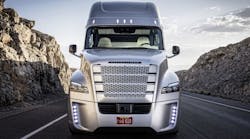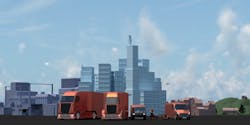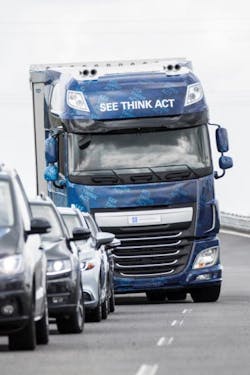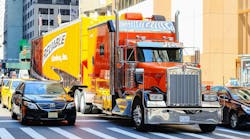The mistake many make when predicting adoption rates for autonomous vehicle (AV) technology in the freight business is that trucking is not a “homogenous” industry, stressed Richard “Dick” Metzler, chief marketing officer for online delivery firm uShip Inc.
That’s why, in his view, driverless trucks will only become a reality in certain segments of the industry, in operations “where they make sense” such as in long-haul duty in “out in the open spaces of [the] west where you’ve got big square states.”
“Trucking is really an industry made up of sub-markets,” he explained with many of them “super tough” for autonomous technology to handle, such as: urban pickup and delivery; flatbed operations, where the tarping and securing of loads is critical; and refrigerated operations where the monitoring of reefer units is critical.
“Those are tougher to do and I think we’ll see autonomous [technology] only play a role in those segments much later on,” he noted.
That being said, Metzler – whose freight career includes stints with FedEx, APL Logistics, and DHL Express – believes that by 2026, driverless truck technology will evolve into a core complement, though not a full replacement, of what we know in trucking today.
“It’s now just a matter of when and no longer a question of if it’s going to happen; the economics are too compelling and the logistics are too compelling,” he stressed. “But it won’t be a ‘one size fits all’ approach; it’ll happen segment by segment.”
Sandeep Kar, global vice president-mobility research for the transportation practice within global consulting firm Frost & Sullivan, noted that automation may very well make the job of operating a commercial truck not only more attractive to workers but more profitable for drivers and fleets alike.
“A driver not driving can be on the Internet, connected to the ‘outside world’ and actually look for spare freight – generating more revenue for the [trucking] company and probably more pay for themselves as well,” Kar said.
“It starts with driver satisfaction, for both existing and future truck operators,” he explained. “Drivers won’t have to physically operate the truck for long periods as the [autonomous] technology will allow them to take breaks and stay connected with the world outside while in the cab. That ‘connectivity’ will be very important for recruiting younger drivers.”
Increased fuel efficiency and lower maintenance costs from more “optimized” truck operation due to autonomous guidance systems, alongside improved safety performance, will round out the gains fleets should get from so-called “driverless” trucks, Kar added.
Especially in long-haul operation, he believes autonomous technology could not only help alleviate the driver shortage but also offer an alternate to wage hikes as it would provide drivers with a less-stressful and safer work environment.
Metzler also believes “single pilot drivers” will soon lead platoons of two to three separate trucks, caravan style, so more freight can be moved longer distances. “This is where one driver can do the work of three,” he emphasized, with freight transported the “first and final mile” by manned trucks, or even Uber-like managed truck drivers.
Frost & Sullivan’s Kar pointed out that platooning is really the “first step” in the automation of trucks – and his research indicates that platooning should debut on U.S. highways as early as 2019-2020, with "Level 4" autonomous trucks (fully driverless-capable vehicles) projected to enter the U.S. market around 2030. In the meantime, more and more trucks will be equipped with driver assistance technology that forms the fundamental structure of an autonomous truck, he said; technology such as such as radar sensors, cameras, automatic emergency braking (AEB) and the like.
“Here, drivers could take say two hour turns driving at the head of a platoon, then switch with another driver,” Kar explained. “It allows them to ‘disengage’ with driving for set periods and that would probably help attract more entrants to the profession. That’s why we see a possible solid ROI [return on investment] for this technology.”
But uShip’s Metzler thinks that won’t happen anytime soon in either the “first” or “last mile” segments of the logistics business.
“At least in my lifetime, there will always be some human element needed at pickup and delivery due to the variances and judgment required when dealing with delays, waiting, scheduled deliveries, breakdowns, docks, lift gates and more,” Metzler added.
Yet not everyone thinks “last mile” operations won’t be conducive to driverless trucks.
A recent study authored by global vehicle component manufacturer ZF and the Fraunhofer Institute for Material Flow and Logistics (IML) entitled Urban Logistics of the Future predicts that autonomous driving will actually play an “ever-increasing role” during last mile operations – yet also cautions that “various social and infrastructure requirements” must be fulfilled first before that occurs.
“The parcel delivery sector is growing at great speed. In 2015, more than 2.9 billion parcels were sent in Germany alone – one billion more than in 2005,” noted Prof. Uwe Clausen, head of the IML and the study’s author, in a statement.
“This trend is expected to continue over the coming ten years,” he added. “More and more customers are purchasing goods online, and with convenience orders and same-day delivery now available, consumers expect their goods to be delivered to their doorsteps in just a few hours – fresh and chilled.”
There are other factors as well: Driving bans, low emission zones and the desire to reduce traffic noise mean that new delivery options are necessary.
“Those requirements come into play during the ‘last mile,’ the last step in the delivery process to the customer,” Clausen stressed.
His research indicates that autonomous vehicles could reduce driver stress and compensate for the lack of skilled workers – and that the technology to do so is not “unfamiliar” to drivers and the general public as a whole.
“One advantage is that considerable progress has been made in this area [as] driver assistance systems and semi-autonomous driving technologies are already well established, and a few autonomous vehicles have already been tested on the road,” Clausen pointed out.
"The basic technologies are already available,” he noted. “The question, however, is whether the infrastructure and the logistics economy are prepared."
One example Clausen emphasized: safety issues. “How can we ensure that an automated vehicle detects a construction site which is not properly 'sign-posted' or is not confused by incorrect lane markings? This is a key factor for autonomous delivery trucks to achieve social acceptance and offer economic advantages,” he said.
uShip’s Metzler agrees with that part of Clausen’s assessment at least. “The ability of the driver to react when not paying attention is the big issue,” he said, noting that when a driver does “re-engage” in an emergency situation it can often make things worse from a safety perspective because they overact.
Metzler’s point of view is that safety is the “paramount” factor for any trucking operation – “if you don’t have that, you don’t have a trucking company” – and that trucking can obviously play a big role in improving safety since human error remains a leading cause of vehicle crashes.
“You’ve also got to assure ‘Joe America’ that it [driverless technology] is safe,” he stressed.
He believes that if the adoption rate for driverless technology is “slow” to “gradual,” there won’t be as much pushback from truck drivers or the general public.
“If it occurs gradually it won’t be that much of a big deal even though it’s disruptive,” Metzler said. “Look at Uber: it gradually disrupted the taxi industry and while there’s been pushback among taxi drivers, everyone’s adjusted to it. Something similar can occur in trucking but it will take a longer timeline to achieve.”






